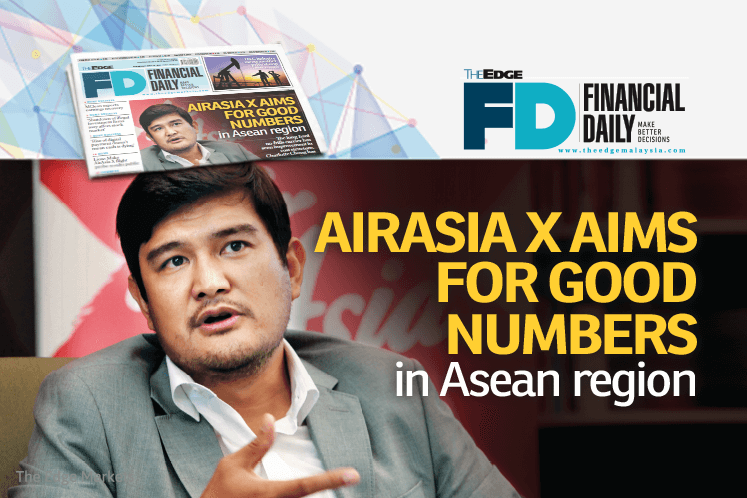
This article first appeared in The Edge Financial Daily on June 28, 2017
SEPANG: AirAsia X Bhd (AAX), the long-haul arm of AirAsia Bhd, remains confident of generating better financial numbers in the Asean region in the second half of the current year, although a weak ringgit and higher fuel costs pulled the no-frills airline back to losses in the first quarter ended March 31, 2017 (1QFY17).
The confidence of the no-frills airline stems from its improving cost structure. “The most important thing is our KPIs (key performance indicators). Our statistics within the organisation are improving [despite the lower 1Q earnings],” its chief executive officer (CEO) Benyamin Ismail told The Edge Financial Daily in conjunction with its newly launched route between Kuala Lumpur and Honolulu, Hawaii.
Benyamin, who took over the CEO office in September 2015, said that the key focus was to ensure that AAX is disciplined with consistent sales numbers. “Our focus is to ensure that we achieve good numbers for the third and fourth quarters.”
AAX’s net profit for 1QFY17 shrank 94% to RM10.34 million from RM179.49 million last year. It attributed the severe earnings contraction to the weaker ringgit and higher fuel prices. Analysts believe the intensive competition that has suppressed yield is also the headwinds that AAX is facing.
Some analysts view that the disappointing quarterly earnings numbers could be the reality of the low-cost carrier, at least in the near future. Its share price took a nosedive in May, dropping from the more than three-year-high peak of 53 sen to 40 sen. It closed at 41 sen last Friday, trading at a historical price-earnings ratio of 29.3%, according to Bloomberg, compared to its parent AirAsia Bhd, which is trading at barely 5.31 times.
However, Benyamin pointed out that its cost for available seat kilometre (ASK) indeed dropped in 1QFY17, stressing that it is crucial to ensure that cost remains low on a sustainable manner.
According to the airline’s announcement to Bursa, its cost per ASK dropped 1% to 13.48 sen.
On its newly launched Kuala Lumpur-Osaka-Honolulu route, Benyamin said, “It has exceeded our expectation. For the first few flights, our load factors are about 98%, predominantly a lot of traffic is coming from Japan.”
He added that its forward bookings for the next four to five months on the Hawaii route are at about 80%. “If we can keep it consistently at above 80%, we can break even pretty quickly.”
“We are quite optimistic and one of the key things is that Japan is a very high-yield market.”
“For Japanese, Hawaii is the No 1 destination. The demand is exceeding the supply,” He explained that there is no competitive environment in Osaka, where the airlines are not thrashing fares.
Benyamin acknowledged that the most important thing now is to build the brand in the US. “Hawaii is a good start. Once we are strong enough, then we will move to the West Coast.”
When asked about AirAsia Group founder Tan Sri Tony Fernandes’s comment on not expanding routes to Europe, Benyamin said, “We do not have the aircraft to go to Europe. Of course we can source [for] aircraft, [but] it will take another year or so.”
He said that it would wait for the market to be more mature before considering going into that space. “At the moment, those markets are still irrational [in terms of competition] and I think we are not ready to battle that out yet.”
“We will look at this game again in another two to three years.”
Fernandes stated once that ultra-long-haul flights are “not relevant”. Nonetheless, Benyamin said flights longer than eight hours could be possible routes AAX would consider in the foreseeable future.
He reasoned, “If you do 10 hours you only sell one set of revenues. We try to utilise the aircraft more.”
Benyamin pointed out that the focus is on finding routes that it has never flown or increasing frequencies of existing routes that are doing very well.
For AAX, its lucrative routes have been China and South Korea with its plans to launch two more destinations in China by the end of this year.
“There are so many cities that we still have not touched [in China] ... only first-tier cities at the moment like Beijing and Shanghai,” he said.
AAX flies to eight cities in China including Xi’an, Hangzhou, Beijing and Shanghai. As a group, it flies to 28 cities. For now, it is trying to attract more second-tier cities, according to Benyamin.
On the news about Singapore Airlines and Cathay Pacific retrenching staff, Benyamin takes it positively from AAX’s perspective.
“There will be an opportunity for us. AirAsia Group has been one of the lowest pioneers in terms of cost structure and we will maintain that.
“It takes a while [for them] to restructure what their direction is and they need to move their yields up. Then it becomes rational for us because then we could also move our yields up.”
Benyamin said AAX can compete because of its cost structure, but it’s difficult for the other airlines because their cost structure isn’t there.
Talking about aircraft expansion, Benyamin said it is not looking to get any new aircraft this year but it will add another two towards the end of next year.
At the moment, AAX has 22 aircraft in Malaysia, six in Thailand and two in Indonesia.
Although he said that the “skies are getting busier”, Benyamin remains optimistic that there are opportunities on the horizon for AAX to grow. “The important thing is to grow in the markets that you are confident with.”